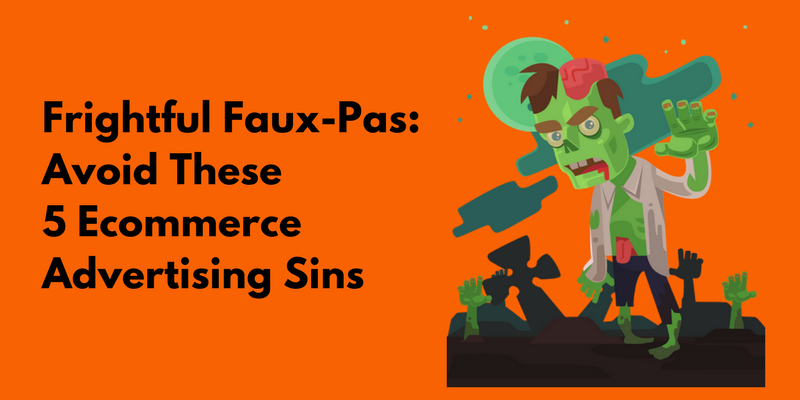
- October 30, 2017
- Advertising, Ecommerce
Frightful Faux-Pas: Avoid These 5 Ecommerce Advertising Sins
Yes, Halloween is coming up, but that doesn’t mean your ecommerce advertising strategy needs to be scary. We’re guiding you through the missteps and keeping you away from five ecommerce advertising nightmares. Keep your customers from ghosting you by avoiding these five deadly sins during this spooky season (and, you know, always):
- Winging it

No strategy. No research. No tracking. Sounds like a winning ecommerce advertising formula, am I right? NO. Come on, you know better than to go in blind with your hands tied behind your back!
Tracking is especially important to determine your ecommerce advertising strategy as you move forward. Document everything you change; this includes placements, copy, and images. What worked? What didn’t? Let the data inform your strategy, and stay fluid so you can adjust based on your learnings.
- Living in Broad City

One of the best things about ecommerce advertising on Facebook is the ability to target exactly who you’re looking for – you can get scary granular! A huge mistake so many people make when advertising on Facbeook is not taking advantage of their targeting and instead creating extremely broad audiences or worst of all, no targeting at all. Facebook allows you to target your audience by (among a LOT of other things):
- Education level
- Income level
- Interests
- Upcoming life events or friends’ life events (ex: female with a close friend having a birthday within two weeks)
- Buyer profiles
- Email domain
You can also exclude people based on the same criteria. Sure, take a minute to be freaked out by how much Mark Zuckerberg knows about your life, but then take advantage of this information goldmine and then advertise straight to your target audience.
With so many audience options, remember that you don’t always need to use the same one. Test different audiences that are relevant to your business and see how they respond to different ecommerce advertising tactics. If you’re ever unsure of which audience you should be targeting to for a specific promotion, test both! What you learn from one ad set will help you in the future.
- Not ‘Gramming a Pretty Picture

Whoever said “a picture is worth a thousand words” definitely never thought Instagram was gonna be a thing, but the sentiment is truer now than ever before. Your 15-year-old niece has a visual brand, so your business better have one too. To achieve this, use photos in your ecommerce advertising that are true to your brand and reflect what you’re selling. It’s not surprising to learn that in 2015 51% of B2B marketers identified creating visual assets as a priority for the coming year (Content Marketing Institute).
Even if you don’t have an in-house creative team at your disposal, you can still find ways to invest in your photography. Consider your resources and think about if it makes sense for you to contract someone for a few days to capture as many brand images as you can think of. Additionally, tools like Canva allow you to make sure your images are properly sized for each channel and placement, and make it easy for you to spruce up images or add text even if your graphic design skills aren’t top notch!
It might make the most sense for you to use stock photography—we know, we’re cringing right along with you at all those “woman-laughing-while-eating-a-salad” pics. Don’t worry, we’d never leave the fate of your ecommerce advertising in the hands of bad stock image tropes. You can find some amazing stock photo alternatives if you know the right places to look.
- Having Cold Copy

You should know by now this is not a one-and-done kind of situation.
Catch your audience’s eye by refreshing your copy often. This is a way for you to showcase your brand’s personality, so take advantage and get creative! Having the same copy on every ad is a big don’t here.
Stay current and relevant, both in terms of your business (sales, discounts, active promo codes, etc.) and in terms of the season, keeping in mind any upcoming holidays or events that you’re targeting.
Finally, you may not be surprised to learn that nearly a third of people never actually read a Facebook post or ad further than the headline before they share it (Washington Post). The takeaway? Keep your headline copy fresh and to the point to encourage engagement!
- Quitting Before You’re Ahead

You’re trucking right along with your ecommerce advertising when you realize that you’re one week in and haven’t seen any results. Time to pack it in, right? Again, NO.
As in most other parts of life, patience is a virtue when it comes to ecommerce advertising—don’t shut your campaign off after a few days or a week in because it’s not performing the way you want. Campaigns can take a while to find their groove! Give it at least 48-72 hours before you make any initial changes (and don’t you dare shut off them off). Every time you do make major changes, take about 24-48 hours before drawing any conclusions.




Leave a Reply
You must be logged in to post a comment.